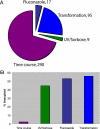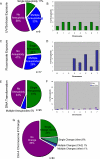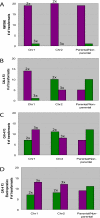Aneuploid chromosomes are highly unstable during DNA transformation of Candida albicans
- PMID: 19700634
- PMCID: PMC2756872
- DOI: 10.1128/EC.00209-09
Aneuploid chromosomes are highly unstable during DNA transformation of Candida albicans
Abstract
Candida albicans strains tolerate aneuploidy, historically detected as karyotype alterations by pulsed-field gel electrophoresis and more recently revealed by array comparative genome hybridization, which provides a comprehensive and detailed description of gene copy number. Here, we first retrospectively analyzed 411 expression array experiments to predict the frequency of aneuploidy in different strains. As expected, significant levels of aneuploidy were seen in strains exposed to stress conditions, including UV light and/or sorbose treatment, as well as in strains that are resistant to antifungal drugs. More surprisingly, strains that underwent transformation with DNA displayed the highest frequency of chromosome copy number changes, with strains that were initially aneuploid exhibiting approximately 3-fold more copy number changes than strains that were initially diploid. We then prospectively analyzed the effect of lithium acetate (LiOAc) transformation protocols on the stability of trisomic chromosomes. Consistent with the retrospective analysis, the proportion of karyotype changes was highly elevated in strains carrying aneuploid chromosomes. We then tested the hypothesis that stresses conferred by heat and/or LiOAc exposure promote chromosome number changes during DNA transformation procedures. Indeed, a short pulse of very high temperature caused frequent gains and losses of multiple chromosomes or chromosome segments. Furthermore, milder heat exposure over longer periods caused increased levels of loss of heterozygosity. Nonetheless, aneuploid chromosomes were also unstable when strains were transformed by electroporation, which does not include a heat shock step. Thus, aneuploid strains are particularly prone to undergo changes in chromosome number during the stresses of DNA transformation protocols.
Figures





References
-
- Ahmad, A., M. A. Kabir, A. Kravets, E. Andaluz, G. Larriba, and E. Rustchenko. 2008. Chromosome instability and unusual features of some widely used strains of Candida albicans. Yeast 25:433-448. - PubMed
-
- Andes, D., A. Lepak, J. Nett, L. Lincoln, and K. Marchillo. 2006. In vivo fluconazole pharmacodynamics and resistance development in a previously susceptible Candida albicans population examined by microbiologic and transcriptional profiling. Antimicrob. Agents Chemother. 50:2384-2394. - PMC - PubMed
-
- Andes, D., A. Lepak, A. Pitula, K. Marchillo, and J. Clark. 2005. A simple approach for estimating gene expression in Candida albicans directly from a systemic infection site. J. Infect. Dis. 192:893-900. - PubMed
-
- Bachewich, C., A. Nantel, and M. Whiteway. 2005. Cell cycle arrest during S or M phase generates polarized growth via distinct signals in Candida albicans. Mol. Microbiol. 57:942-959. - PubMed
Publication types
MeSH terms
Substances
Grants and funding
LinkOut - more resources
Full Text Sources
Research Materials

